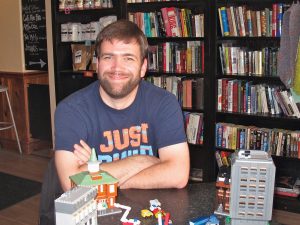
All grown up and no longer playing with Lego? Wellington resident Joel Hoornbeek, a 37-year-old father of six, thinks that’s sad.
The t-shirt he’s wearing says “Just Build.” His sweatshirt sports a Lego logo. And he’s a member of a nine-person Colorado/Wyoming Lego Users Group team that recently completed a year-long Lego project, “Hit the Bricks,” that was commissioned by the University of Colorado in Boulder. They recreated the main campus in plastic bricks and in incredibly realistic detail, including iconic CU buildings such as Old Main, Macky Auditorium and Folsom Field. The finished micro-campus is located at the CU Heritage Center on the third floor of Old Main on the CU campus.
Hoornbeek’s parents gave him his first Lego set when he was three. Never again did they need to ask him what he wanted for Christmas or a birthday. “Lego or money to buy Lego,” was his long-standing answer.
The Lego company, based in Denmark, produces 19 billion pieces a year and recently passed up Hasbro as the world’s number one toymaker. The founder was a woodworker who moved into plastics in the 1940s when the first injection molding machines were available.
Hoornbeek, who with his wife Kylie homeschools his children ages two to twelve, understands why. In an effort to explain why Lego continues to fascinate him, Hoornbeek said, “It’s about the orderliness, the structure of the pieces that fosters creativity.”
Every one of his kids — and his wife as well — have bought into his passion. Even his two-year-old has moved beyond the compulsion to put the pieces in his mouth and instead loves to play with the tiny Lego figures.
Hoornbeck suggests that if you aren’t familiar with Lego, introduce yourself by purchasing a five dollar set at Walmart and building it according to the directions given on the box. “Then take it apart and build something on your own.”
A Colorado native, who grew up in Granby and moved to Fort Collins, came by his entrepreneurial instincts by living with a father who made his living as a software developer. Hoornbeek, who was home-schooled by his parents, learned about business at Front Range Community College before embarking on his own career as a software developer.
For a year and a half, Hoornbeek worked for Lego. “A dream job,” he said. He worked with a team developing a digital game based on Lego. Eventually the project, located in Louisville, was abandoned and since that time Hoornbeek has made his living as a freelance software designer, working out of his home.
He is a loyal member of CoWLUG, a 10-year-old organization with 40 active members who meet sporadically, but who came together full force to complete the CU Heritage Center project and will continue to enhance it during the coming year.
Members come from Laramie and as far away as Colorado Springs and like the idea of no set meetings. They simply enjoy the opportunity to say, “Hey, let’s get together to build and barbecue” when the spirit hits.
Each year CoWLUG presents its work at places like the Colorado Mills Mall in Denver or the Longmont Museum where they had a summer-long exhibition. The fact that they were commissioned by the CU Heritage Center made it possible for them to purchase the Lego parts they needed rather than supplying their own.
Hoornbeek has given some thought to the reasons why Lego advocates pursue their passion. “Everyone’s different,” he said. “Some like to buy a box of Legos and follow the instructions to a T. Others will only create free form. Still others are into the collecting aspect of Lego. Some focus on the miniatures, doll house models, robotics, puzzles or Rubik’s Cubes. Then there are those who pursue Lego as sculptors, building large-scale items from basic bricks.
“It’s not just a kids’ toy,” Hoornbeek insists.
A Legos Ideas website exists where aficionados can suggest ideas that have a chance of being picked up by the company. A birdwatcher from the United Kingdom suggested bird models and this year Lego is offering a robin, hummingbird and blue jay built from Lego bricks.
Perhaps, the next time you pick up a Lego brick, you’ll see it as more than a tiny piece of plastic, molded so that it can fit into another piece with the same set of bumps and holes.
For many, it has become a delightfully creative lifestyle.
Support Northern Colorado Journalism
Show your support for North Forty News by helping us produce more content. It's a kind and simple gesture that will help us continue to bring more content to you.
BONUS - Donors get a link in their receipt to sign up for our once-per-week instant text messaging alert. Get your e-copy of North Forty News the moment it is released!
Click to Donate


